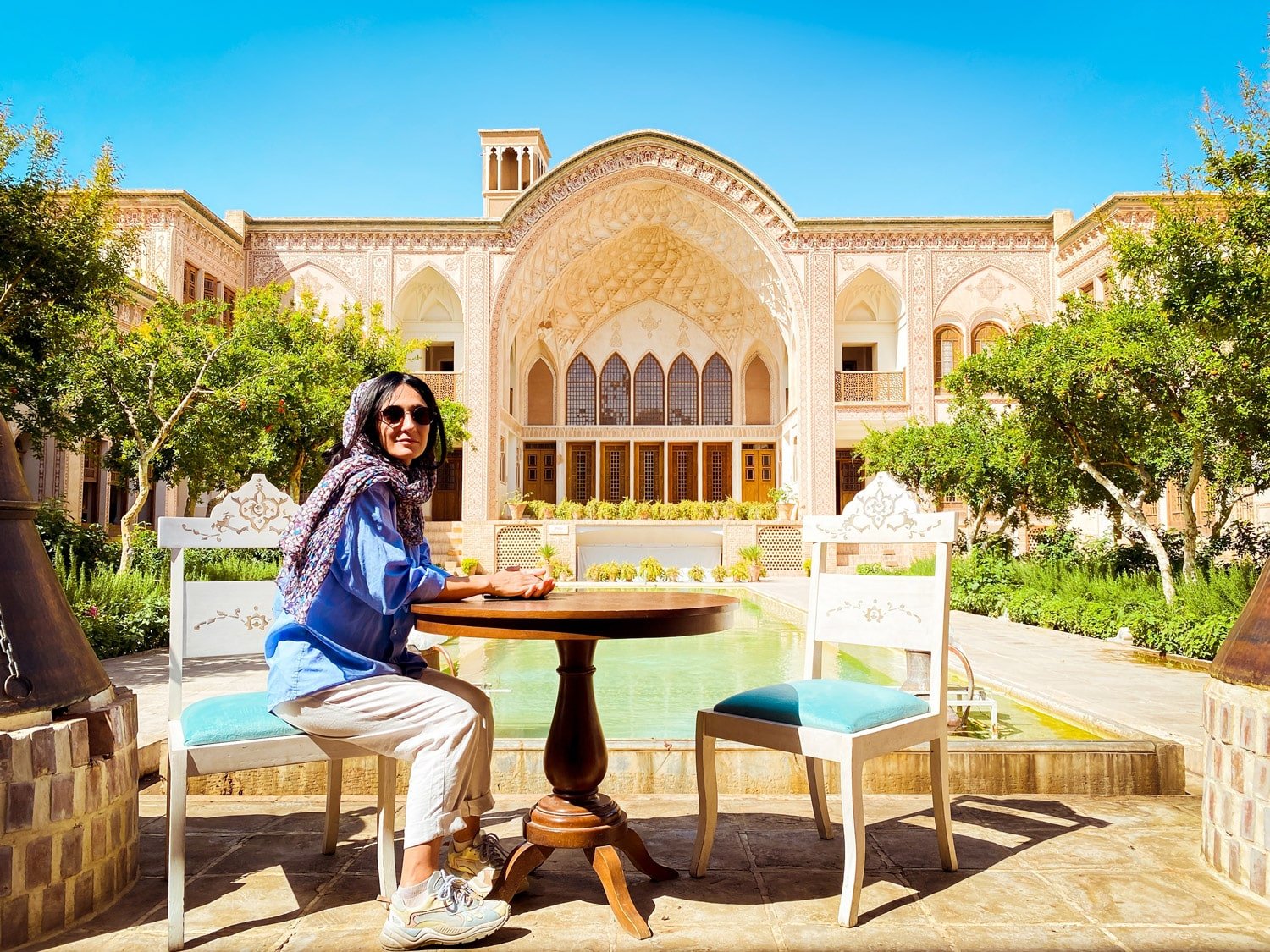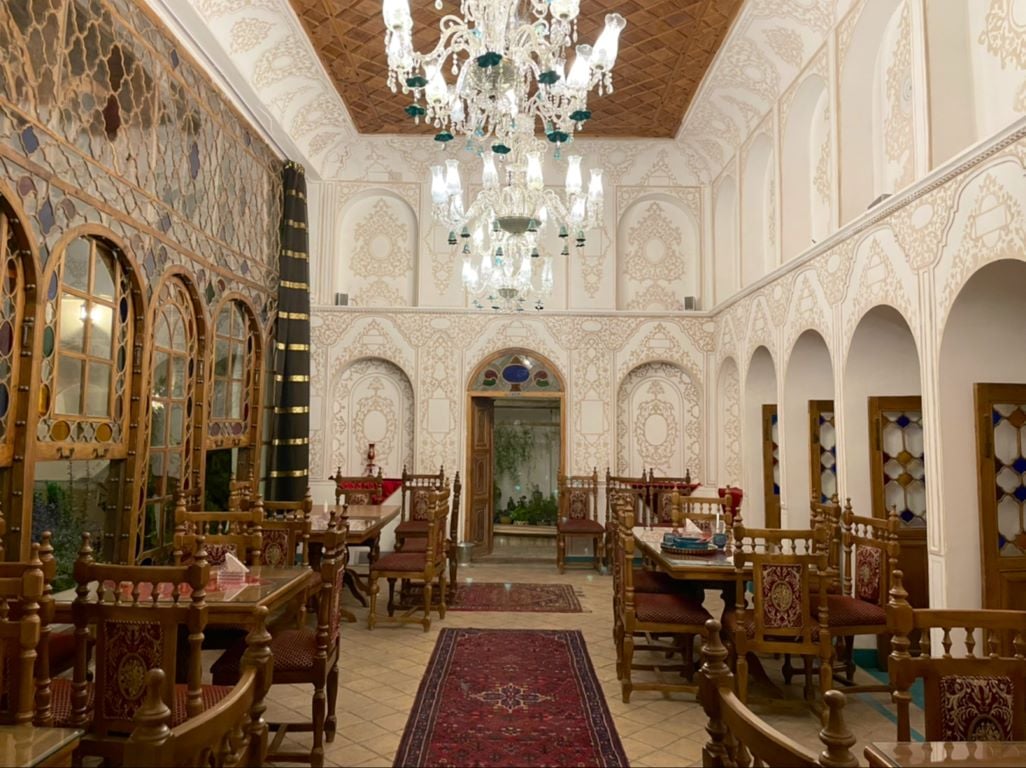Iran’s Traditional Houses: The Beauty of Persian Architecture
What are traditional houses in Iran like?

Traditional houses are one of the jewels of Iran and the Persian culture. In Kashan, Isfahan, Yazd, and other cities of Iran, they’ll often be among the highlights of your visit. They showcase Persian art and an open book about people’s traditional way of life.
There is no need to be a fan of architecture to appreciate the exceptional features of Iranian traditional houses. With a delicate design, full of beautiful mirror-work, woodwork, and paintings, they are the perfect embodiment of Persian art and culture.
Contents
Houses built for their environment

Iran being a four-season country with, in some areas, hot summers and, in some others, freezing winters, one of the main features of all traditional houses is the fact that they are built according to the weather. This is visible from the materials used to create the walls, but also from the presence of one or several wind towers, “badgir“, the world’s oldest cooling system.

Furthermore, traditional houses are oriented north-south to use the different parts of the house depending on the temperatures: in winter, the south part exposed to the sun was used, while in summer, people would occupy the north part of the house that has less sun exposure, and is thus cooler.
The importance of guests
Besides the weather, the architecture of traditional houses of Iran is based on their social function. If a house’s primary purpose is to be a living place for a family, in Iran, the house has also always been a place to receive guests. Having guests in the Persian culture is central, and the more luxurious the house is, the more sophisticated must be the way guests are welcomed.
Traditional houses are built with two separate parts, one called “birouni”, dedicated to the guests, and the other one called “andarouni”, that was used by the family and the servants. It allows these latter, and in particular women who may not have wanted to be seen, to navigate the house without having to cross the areas where the guests are staying.

Often, houses have a dedicated room to receive the guests, which varies in size depending on the family’s wealth. It is called “Shahneshin” (that could be translated to “the king’s room”) for the most luxurious, or “Talaar”, “Neshiman” and “Majles” for the simplest ones. “Shahneshin” are very eye-catching spaces, ornated with beautiful mirror-work and paintings. One of the best examples is the Mollabashi House, in Isfahan.
These rooms also display colored windows, a typical element of Persian culture. Not only would it add artistic value to the house, but the colors also protect the rooms from the light and prevents some insects from coming in.
The specificities of the traditional architecture
From outside the street, passersby can hardly guess the beauties that are on the other side of the wall. Indeed, traditional houses usually have a simple frontage. Rich traditional houses have a more sophisticated doorway, though, with engraving, calligraphy, a semi-dome, as well as two platforms on both sides to lead to the door. This area was used to talk with the house’s owner when the guests didn’t want to enter the house.

Wooden doors are systematic features of the traditional houses, on which two door knockers are always attached. Called “Kubeh”, these two knockers have different sizes and produce different sounds: one was used by the male guests, the other by the female guests, so that the person opening the door could know whether he or she was expecting a man or a woman.
Once passed the door, the guests would cross an antechamber called “Hashti”, leading to the central courtyard. All traditional houses have a central courtyard, which is where the family members would often gather. In the middle is a small pool, called “howz”, often decorated with flowers. Rooms are all around the rectangular yard, and would be occupied by the family on several generations, all living together.

Inside the house, there would be little if no furniture. It was only from the Qajar era, under the influence of the European style, that houses were progressively furnished in Iran. Traditionally, the most essential element of the room is the carpet, as people would sit on the floor to talk, have tea, and share food. Large cushions are placed against the walls, so that people can lay back. And when comes the time to sleep, they would bring floor mattresses, later put away when unused.
How and where to visit traditional houses in Iran?
It’s unthinkable to visit Iran without visiting a few traditional houses. Unfortunately, many have been destroyed in the past centuries, in particular in the capital city, Tehran. Hopefully, plenty of them are now being renovated and turned into museums, hotels, cafes, and restaurants, so that the travellers can fully appreciate them.
There are traditional houses of various local architecture in all regions of Iran. However, central Iran is where the most beautiful traditional houses can be admired. And the good news is that it’s probably your destination as well! Let’s have a look at some of the traditional houses you can enjoy in four of the main cities of Iran: Kashan, Isfahan, Yazd and Shiraz.
Traditional Houses of Kashan
Kashan is the main city in Iran to admire traditional houses, as it holds some of the most beautiful. These traditional houses belonged to rich merchants of the 19th century. Each of them has a unique architecture and an exceptional interior design that are the best illustrations of the beauty of Persian architecture.
Boroujerdi House, Tabatabei House, Ameri House, Abbasi House are the three most famous traditional houses to see while in Kashan. You can visit them with a small entrance fee. You can also appreciate Morshedi House and Manoucheri House for their restaurant. These two also are beautiful hotels you can stay at. Along with them, we recommend you the following hotels in Kashan to experience a night in a traditional house:
- Saraye Ameriha Boutique Hotel
- Darbe Bagh Residence
- Adib House Boutique Hotel
Traditional Houses of Isfahan

Isfahan is another great destination to appreciate traditional houses, with a lot of amazing houses dating from the great dynasty of the Safavid. Now turned into a hotel, Mollabashi House has one of the most beautiful and photogenic “Shahneshin”. You can also appreciate tea in the yard of Abbasi Hotel, that was not a house but a caravanserai. And on top of this, we highly recommend you stay at one of these hotels:
- Ghasr Monshi
- Bekhradi House
- Keryas Boutique Hotel
- Isfahan Traditional House
- Kianpour House
- Keshish House
Traditional Houses of Shiraz
Going further south, the atmosphere changes a bit as you approach Shiraz. In this city famed for roses, orange blossoms, an

d poetry, the refinery of its house is comparable to Isfahan’s and Kashan’s. Don’t miss the visit to Qavam House, located in the Naranjestan Garden, once the residence of Shiraz’s ruling family under the Qajar dynasty. Zinat ol-Molk is another beautiful traditional house that has now become a museum. You’ll also find plenty of smaller houses turned into cafes and hotels, such as:
- Emarat Fil (Elephant Boutique Hotel)
- Aghazadeh Boutique Hotel
- Darb-e Shazdeh
- Homayouni Hostel
- Forough Traditional Hotel
Traditional Houses of Yazd
Traditional houses of Yazd tend to differ from the other cities of Iran. One of the most iconic is Aghazadeh House, a beautiful Qajar house located in Arbakooh, near Yazd. Malek-o Tojjar is another beautiful traditional house that once belonged to a rich merchant close to the Qajar king Naser al-din Shah. As Yazd is a desert city, all houses have one or several windcatchers. They are also singular for using their rooftop, now often used as cafes. Here again, don’t miss your chance to stay in one of Yazd’s traditional houses during your stay:
- Moshir Al-Mamalek
- Naranjestan Traditional House
- Saraye Shaarbaf
Read More




